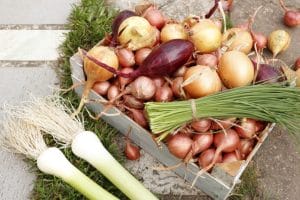 Onions are at the top of my list because these pearl varieties can easily be pickled or dried and powdered to provide you with excellent onion flavor through the winter months. They are also considered to be nutrient-dense food. This means that they contain a small number of calories and a large number of nutrients. They are a great source of potassium and manganese. You aren’t limited to just pearl onions. Many varieties will reach maturity with a decent-sized bulb in a short amount of time, and they can withstand a slight frost. Even when picked early, onions will have green tops and all the flavor you want. As with any plant you are evaluating, consider how many days you have from when you plant to that first frost. If you have to harvest onions early, no problem. They will just be smaller in size. It isn’t like you have to wait for onions to ripen.
TOMATOES
Onions are at the top of my list because these pearl varieties can easily be pickled or dried and powdered to provide you with excellent onion flavor through the winter months. They are also considered to be nutrient-dense food. This means that they contain a small number of calories and a large number of nutrients. They are a great source of potassium and manganese. You aren’t limited to just pearl onions. Many varieties will reach maturity with a decent-sized bulb in a short amount of time, and they can withstand a slight frost. Even when picked early, onions will have green tops and all the flavor you want. As with any plant you are evaluating, consider how many days you have from when you plant to that first frost. If you have to harvest onions early, no problem. They will just be smaller in size. It isn’t like you have to wait for onions to ripen.
TOMATOES
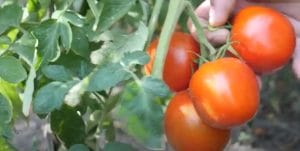 Yes, there’s still time. If you want to get a last batch of tomatoes in before the first frost, consider a variety that harvests early and can withstand colder temperatures like the aptly named Sub Arctic Plenty. It’s a determinate variety that will only grow to a certain height. That makes it ideal for container gardens or any gardener with space challenges. The Red Pear is an indeterminate variety if space isn’t an issue. It will quickly give you loads of fruit, perfect for salads, pizza, or right off the vine. It’s not frost tolerant, so you will want to get it in the ground now and harvest the last of it before your first frost.
ALASKA EARLY PEAS
Yes, there’s still time. If you want to get a last batch of tomatoes in before the first frost, consider a variety that harvests early and can withstand colder temperatures like the aptly named Sub Arctic Plenty. It’s a determinate variety that will only grow to a certain height. That makes it ideal for container gardens or any gardener with space challenges. The Red Pear is an indeterminate variety if space isn’t an issue. It will quickly give you loads of fruit, perfect for salads, pizza, or right off the vine. It’s not frost tolerant, so you will want to get it in the ground now and harvest the last of it before your first frost.
ALASKA EARLY PEAS
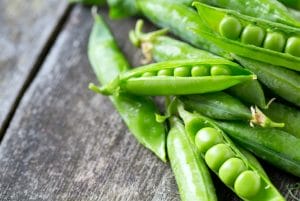 The Alaska Early Pea is a remarkable variety that offers quick yields in just 55 days. Despite its name, this versatile pea can be cultivated in Alaska, the lower 48 states, and even Hawaii. It boasts a semi-dwarf growth habit, reaching a height of 2-3 feet, and doesn’t need staking for support. This frost-tolerant bush variety is well-suited for various climates, making it a reliable choice for gardeners seeking early harvests and compact, hassle-free pea plants.
BRASSICAS
The Alaska Early Pea is a remarkable variety that offers quick yields in just 55 days. Despite its name, this versatile pea can be cultivated in Alaska, the lower 48 states, and even Hawaii. It boasts a semi-dwarf growth habit, reaching a height of 2-3 feet, and doesn’t need staking for support. This frost-tolerant bush variety is well-suited for various climates, making it a reliable choice for gardeners seeking early harvests and compact, hassle-free pea plants.
BRASSICAS
 Vegetables that are all part of the Brassica family are some of your typical Fall vegetables because they grow fast and are frost-tolerant. This family includes Spinach, Cabbage, Kale, Broccoli, Cauliflower, and Brussel Sprouts. Growing these in cooler fall temperatures also helps to control the bugs that like to infest and eat these before you harvest. As colder temperatures come in late October and November, these plants are hardy enough to withstand them.
LETTUCES
Vegetables that are all part of the Brassica family are some of your typical Fall vegetables because they grow fast and are frost-tolerant. This family includes Spinach, Cabbage, Kale, Broccoli, Cauliflower, and Brussel Sprouts. Growing these in cooler fall temperatures also helps to control the bugs that like to infest and eat these before you harvest. As colder temperatures come in late October and November, these plants are hardy enough to withstand them.
LETTUCES
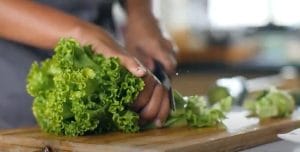 Plants in the Lettuce family will not survive frost well. Some are fine in cooler temperatures. They just don’t like frost. They do, however, develop enough to eat copious amounts in a very short amount of time. Their time to harvest ranges from as little as 30 days and as high as around 85 before they will try to bolt to seed. I also like lettuce as an option because it adapts well to indoor grow systems. Whether that’s a windowsill garden of lettuce or a home-built hydroponic tower next to a sliding glass door, you can grow this indoors with minimal effort and year around. One seed packet can keep you in more leafy green salads than one person can eat.
BEETS, RADISHES, TURNIPS, & CARROTS
Plants in the Lettuce family will not survive frost well. Some are fine in cooler temperatures. They just don’t like frost. They do, however, develop enough to eat copious amounts in a very short amount of time. Their time to harvest ranges from as little as 30 days and as high as around 85 before they will try to bolt to seed. I also like lettuce as an option because it adapts well to indoor grow systems. Whether that’s a windowsill garden of lettuce or a home-built hydroponic tower next to a sliding glass door, you can grow this indoors with minimal effort and year around. One seed packet can keep you in more leafy green salads than one person can eat.
BEETS, RADISHES, TURNIPS, & CARROTS
 Consider one of these root vegetables when the worst of summer heat is set to subside in the next month. Beets, radishes, turnips, carrots, and parsnips have leafy greens you can steal off the top and eat as they grow. Don’t trim too much, though, or the root part of the vegetable will be stunted. When you harvest, eat the whole vegetable from leaf to root. Early Wonder Beets can be ready in as little as 50 days, so you could get two harvests out of them before the growing season ends. This was my first year growing Chioggia Beets, and I have a gallon of them pickling right now.
If your gardening problem right now is what to do with all you are harvesting, you may want to check out our video, which is a crash course in pickling the natural way. It covers all the basics to preserve food and get healthier nutrition in your diet naturally.
I highly recommend these large striped beets. They are low maintenance and will thrive with just a steady watering. Some people don’t like beets, so a Daikon radish might be a better option. This will be frost-tolerant, mildly sweet, and will pickle nicely, as well. Carrots and parsnips are great as they will grow in the gaps between your other vegetables. When I harvest a plant, I often will drop some carrot seeds in its place.
SQUASH
Consider one of these root vegetables when the worst of summer heat is set to subside in the next month. Beets, radishes, turnips, carrots, and parsnips have leafy greens you can steal off the top and eat as they grow. Don’t trim too much, though, or the root part of the vegetable will be stunted. When you harvest, eat the whole vegetable from leaf to root. Early Wonder Beets can be ready in as little as 50 days, so you could get two harvests out of them before the growing season ends. This was my first year growing Chioggia Beets, and I have a gallon of them pickling right now.
If your gardening problem right now is what to do with all you are harvesting, you may want to check out our video, which is a crash course in pickling the natural way. It covers all the basics to preserve food and get healthier nutrition in your diet naturally.
I highly recommend these large striped beets. They are low maintenance and will thrive with just a steady watering. Some people don’t like beets, so a Daikon radish might be a better option. This will be frost-tolerant, mildly sweet, and will pickle nicely, as well. Carrots and parsnips are great as they will grow in the gaps between your other vegetables. When I harvest a plant, I often will drop some carrot seeds in its place.
SQUASH
 You may have heard of winter squash varieties, but the name is somewhat deceptive. Winter Squash requires a long growing season of around 100 days. If you plant it in the late fall, it will not have enough time to grow. The time to get your squash seeds in the ground is right now, while the foliage and vines can thrive in the Summer sun. Their name actually comes more from their hard outer skins, which allow them to store easily through the winter months. There are well over 100 different varieties of squash. Consider some of the most versatile and hearty varieties like pumpkin, Acorn, Hubbard, Burgess Buttercup, or Waltham Butternut. Though zucchini and summer squash are thinner-skinned, you can still get these planted right now to enjoy a pre-frost harvest of the tender young fruit. Plus, these summer squashes are best when their fruit is young.
GARLIC
You may have heard of winter squash varieties, but the name is somewhat deceptive. Winter Squash requires a long growing season of around 100 days. If you plant it in the late fall, it will not have enough time to grow. The time to get your squash seeds in the ground is right now, while the foliage and vines can thrive in the Summer sun. Their name actually comes more from their hard outer skins, which allow them to store easily through the winter months. There are well over 100 different varieties of squash. Consider some of the most versatile and hearty varieties like pumpkin, Acorn, Hubbard, Burgess Buttercup, or Waltham Butternut. Though zucchini and summer squash are thinner-skinned, you can still get these planted right now to enjoy a pre-frost harvest of the tender young fruit. Plus, these summer squashes are best when their fruit is young.
GARLIC
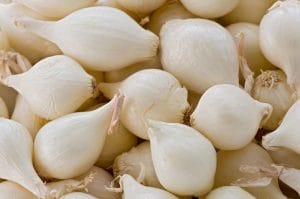 Fall is the prime time to plant hard-neck varieties of garlic, typically from September to November. Opting for fall planting allows the garlic to develop sturdy roots throughout the winter with minimal care. It thrives in cool weather at the beginning of its life, but mature foliage is susceptible to cold damage. You can ensure a successful garlic harvest with robust bulbs and flavorsome results by striking the right balance and providing several weeks of chilly temperatures while avoiding severe freezes. Plant your garlic a little before the first frosts of the year, but avoid planting them right before a big freeze. I just harvested about 60 bulbs of this Spanish Roja variety, and I will take 60 of the largest cloves and plant them for harvesting next Spring. Garlic takes seven to eight months to mature. Three tricks to well-formed bulbs are to clip the ramp when it comes up to allow the plant to focus its energy on the bulb; don’t harvest until you can count four dead leaves up from the base. And start by planting the biggest cloves you have.
WAIT AWHILE
You will also want to get some vegetables in the ground now, even though you can’t really harvest them for a year or more. Asparagus planted now will be harvestable in the second year. Jerusalem artichokes can be planted now but won’t give you much yield before winter. With both, if you simply cut back and mulch over them for winter, they will spring to life with Spring. The same is true for artichoke plants. I didn’t know that for years and would dig mine up at the end of the season. Just a little cutback and mulch over the top through winter, and come Spring, they’ll spring back to life.
As with any Fall garden plant, as you move into late August and cooler temperatures are in the future, you should favor plants that can withstand a slight frost or colder temperatures. If you recognize the importance of growing your own food to increase your food security or you just want to gain the skill of gardening to add to your repertoire, consider getting some or all of these vegetables planted right now. You will gain a skill and be rewarded with food you know isn’t treated with chemicals or pesticides unless you put those on them. Health is an important part of prepping, and much of health comes down to the nutrients you put in your body. Winter is peaking around the corner, even as we swelter through summer. Realize you have an opportunity for an abundant garden if you sow your seeds now. What do you think? What vegetables should people get in their garden right now? Let us know in the comments below.
As always, stay safe out there.
Early Vegetables – https://bit.ly/3psrB2G
Pearl Onions – https://bit.ly/432zPw4
Onions – https://bit.ly/3JCkE5R
Sub-Arctic Plenty Tomatoes – https://bit.ly/3CQwaqz
Red Pear Tomatoes – https://bit.ly/42Y4YRv
Alaska Early Peas – https://bit.ly/3pjsdrr
Spinach – https://bit.ly/44rjEK1
Cabbage – https://bit.ly/3NyGOqK
Kale – https://bit.ly/3PwycUf
Broccoli – https://bit.ly/3rdfS8s
Cauliflower – https://bit.ly/43ZDdJq
Brussel Sprouts – https://bit.ly/3r5fcSI
Ukrainian Garlic – https://bit.ly/3CRNgo3
Spanish Roja Garlic – https://bit.ly/442uPJi
Lettuces – https://bit.ly/3JzmBQF
Early Wonder Beets – https://bit.ly/3XwtAj4
Chioggia Beets https://bit.ly/3WpVaMy
Radishes – https://bit.ly/3kM5nG8
Turnips – https://bit.ly/42YLYlD
Parsnip – https://bit.ly/3JzpqBf
Carrots – https://bit.ly/3Ny9PDe
Squash – https://bit.ly/443ouNB
Early Wonder Beets – https://bit.ly/3XwtAj4
Chioggia Beets – https://bit.ly/3WpVaMy
Daikon – https://bit.ly/3JAR3Kg
All-In-One Fall Seed Pack – https://bit.ly/431N68b
Fall is the prime time to plant hard-neck varieties of garlic, typically from September to November. Opting for fall planting allows the garlic to develop sturdy roots throughout the winter with minimal care. It thrives in cool weather at the beginning of its life, but mature foliage is susceptible to cold damage. You can ensure a successful garlic harvest with robust bulbs and flavorsome results by striking the right balance and providing several weeks of chilly temperatures while avoiding severe freezes. Plant your garlic a little before the first frosts of the year, but avoid planting them right before a big freeze. I just harvested about 60 bulbs of this Spanish Roja variety, and I will take 60 of the largest cloves and plant them for harvesting next Spring. Garlic takes seven to eight months to mature. Three tricks to well-formed bulbs are to clip the ramp when it comes up to allow the plant to focus its energy on the bulb; don’t harvest until you can count four dead leaves up from the base. And start by planting the biggest cloves you have.
WAIT AWHILE
You will also want to get some vegetables in the ground now, even though you can’t really harvest them for a year or more. Asparagus planted now will be harvestable in the second year. Jerusalem artichokes can be planted now but won’t give you much yield before winter. With both, if you simply cut back and mulch over them for winter, they will spring to life with Spring. The same is true for artichoke plants. I didn’t know that for years and would dig mine up at the end of the season. Just a little cutback and mulch over the top through winter, and come Spring, they’ll spring back to life.
As with any Fall garden plant, as you move into late August and cooler temperatures are in the future, you should favor plants that can withstand a slight frost or colder temperatures. If you recognize the importance of growing your own food to increase your food security or you just want to gain the skill of gardening to add to your repertoire, consider getting some or all of these vegetables planted right now. You will gain a skill and be rewarded with food you know isn’t treated with chemicals or pesticides unless you put those on them. Health is an important part of prepping, and much of health comes down to the nutrients you put in your body. Winter is peaking around the corner, even as we swelter through summer. Realize you have an opportunity for an abundant garden if you sow your seeds now. What do you think? What vegetables should people get in their garden right now? Let us know in the comments below.
As always, stay safe out there.
Early Vegetables – https://bit.ly/3psrB2G
Pearl Onions – https://bit.ly/432zPw4
Onions – https://bit.ly/3JCkE5R
Sub-Arctic Plenty Tomatoes – https://bit.ly/3CQwaqz
Red Pear Tomatoes – https://bit.ly/42Y4YRv
Alaska Early Peas – https://bit.ly/3pjsdrr
Spinach – https://bit.ly/44rjEK1
Cabbage – https://bit.ly/3NyGOqK
Kale – https://bit.ly/3PwycUf
Broccoli – https://bit.ly/3rdfS8s
Cauliflower – https://bit.ly/43ZDdJq
Brussel Sprouts – https://bit.ly/3r5fcSI
Ukrainian Garlic – https://bit.ly/3CRNgo3
Spanish Roja Garlic – https://bit.ly/442uPJi
Lettuces – https://bit.ly/3JzmBQF
Early Wonder Beets – https://bit.ly/3XwtAj4
Chioggia Beets https://bit.ly/3WpVaMy
Radishes – https://bit.ly/3kM5nG8
Turnips – https://bit.ly/42YLYlD
Parsnip – https://bit.ly/3JzpqBf
Carrots – https://bit.ly/3Ny9PDe
Squash – https://bit.ly/443ouNB
Early Wonder Beets – https://bit.ly/3XwtAj4
Chioggia Beets – https://bit.ly/3WpVaMy
Daikon – https://bit.ly/3JAR3Kg
All-In-One Fall Seed Pack – https://bit.ly/431N68b


Theis is great! I’m going to plant these right now.